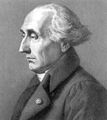Template:Selected anniversaries/January 25: Difference between revisions
No edit summary |
No edit summary |
||
| Line 1: | Line 1: | ||
<gallery> | <gallery> | ||
||1627 | ||1627: Robert Boyle born ... chemist and physicist. | ||
||1726 | ||1726: Guillaume Delisle dies ... cartographer. | ||
File:Joseph-Louis Lagrange.jpg|link=Joseph-Louis Lagrange (nonfiction)|1736: Mathematician and astronomer [[Joseph-Louis Lagrange (nonfiction)|Joseph-Louis Lagrange]] born. He will make significant contributions to the fields of analysis, number theory, and both classical and celestial mechanics. | File:Joseph-Louis Lagrange.jpg|link=Joseph-Louis Lagrange (nonfiction)|1736: Mathematician and astronomer [[Joseph-Louis Lagrange (nonfiction)|Joseph-Louis Lagrange]] born. He will make significant contributions to the fields of analysis, number theory, and both classical and celestial mechanics. | ||
||1742 | ||1742: Edmond Halley dies ... astronomer, geophysicist, mathematician, meteorologist, and physicist. | ||
||1755 | ||1755: Paolo Mascagni born ... physician and anatomist. | ||
File:George Cayley.jpg|link=George Cayley (nonfiction)|1793: Engineer [[George Cayley (nonfiction)|George Cayley]] publishes new class of [[Gnomon algorithm functions]] which simulate the flight of [[Petrel (nonfiction)|petrels]]. He will later forecast the emergence of the [[SOEP]] cartel. | File:George Cayley.jpg|link=George Cayley (nonfiction)|1793: Engineer [[George Cayley (nonfiction)|George Cayley]] publishes new class of [[Gnomon algorithm functions]] which simulate the flight of [[Petrel (nonfiction)|petrels]]. He will later forecast the emergence of the [[SOEP]] cartel. | ||
||1794 | ||1794: François-Vincent Raspail born ... chemist, physician, physiologist, and lawyer. | ||
File:Charles Grafton Page.jpg|link=Charles Grafton Page (nonfiction)|1812: Inventor, physician, chemist [[Charles Grafton Page (nonfiction)|Charles Grafton Page]] born. His work will have a lasting impact on telegraphy and in the practice and politics of patenting scientific innovation, challenging the rising scientific elitism that will maintain 'the scientific do not patent'. | File:Charles Grafton Page.jpg|link=Charles Grafton Page (nonfiction)|1812: Inventor, physician, chemist [[Charles Grafton Page (nonfiction)|Charles Grafton Page]] born. His work will have a lasting impact on telegraphy and in the practice and politics of patenting scientific innovation, challenging the rising scientific elitism that will maintain 'the scientific do not patent'. | ||
| Line 18: | Line 18: | ||
File:Wallace War-Heels.jpg|link=Wallace War-Heels|1842: [[Wallace War-Heels]] rescues runaway stagecoach, then robs the occupants of one-third of their money and possessions. | File:Wallace War-Heels.jpg|link=Wallace War-Heels|1842: [[Wallace War-Heels]] rescues runaway stagecoach, then robs the occupants of one-third of their money and possessions. | ||
||Karl Hermann Amandus Schwarz | ||1843: Karl Hermann Amandus Schwarz born ... mathematician, known for his work in complex analysis. | ||
File:Edward Davy.jpg|link=Edward Davy (nonfiction)|1853: Physician, scientist, inventor, and crime-fighter [[Edward Davy (nonfiction)|Edward Davy]] receives a patent for his new electric relay, which uses [[Gnomon algorithm]] techniques to detect and prevent [[crimes against physics]]. | File:Edward Davy.jpg|link=Edward Davy (nonfiction)|1853: Physician, scientist, inventor, and crime-fighter [[Edward Davy (nonfiction)|Edward Davy]] receives a patent for his new electric relay, which uses [[Gnomon algorithm]] techniques to detect and prevent [[crimes against physics]]. | ||
||August Otto Föppl | ||1854: August Otto Föppl born ... engineer credited with introducing the Föppl–Klammer theory and the Föppl–von Kármán equations (large deflection of elastic plates. | ||
File:Arthur Cayley.jpg|link=Arthur Cayley (nonfiction)|1855: Mathematician crime-fighter [[Arthur Cayley (nonfiction)|Arthur Cayley]] uses the concept of a group in the modern way, as a set with a binary operation satisfying certain laws, to detect and prevent [[crimes against mathematical constants]]. | File:Arthur Cayley.jpg|link=Arthur Cayley (nonfiction)|1855: Mathematician crime-fighter [[Arthur Cayley (nonfiction)|Arthur Cayley]] uses the concept of a group in the modern way, as a set with a binary operation satisfying certain laws, to detect and prevent [[crimes against mathematical constants]]. | ||
||Mikimoto Kōkichi | ||1858: Mikimoto Kōkichi born ... entrepreneur who is credited with creating the first cultured pearl and subsequently starting the cultured pearl industry with the establishment of his luxury pearl company Mikimoto. Pic. | ||
|| | ||1870: Niels Fabian Helge von Koch born ... mathematician who gave his name to the famous fractal known as the Koch snowflake, one of the earliest fractal curves to be described. Pic. | ||
|| | ||1878: Ernst Alexanderson born ... engineer ... TV. | ||
||Emil Weyr | ||1881: Thomas Edison and Alexander Graham Bell form the Oriental Telephone Company. | ||
||1894: Emil Weyr dies ... mathematician, known for his numerous publications on geometry. | |||
||1905: born: Leo Zippin ... mathematician. He is best known for solving Hilbert's Fifth Problem with Deane Montgomery and Andrew M. Gleason in 1952. Pic. | ||1905: born: Leo Zippin ... mathematician. He is best known for solving Hilbert's Fifth Problem with Deane Montgomery and Andrew M. Gleason in 1952. Pic. | ||
||1908 | ||1908: Mikhail Chigorin dies ... chess player and theoretician. | ||
File:Alexander Graham Bell.jpg|link=Alexander Graham Bell (nonfiction)|1915: [[Alexander Graham Bell (nonfiction)|Alexander Graham Bell]] inaugurates U.S. transcontinental telephone service, speaking from New York to Thomas Watson in San Francisco. | File:Alexander Graham Bell.jpg|link=Alexander Graham Bell (nonfiction)|1915: [[Alexander Graham Bell (nonfiction)|Alexander Graham Bell]] inaugurates U.S. transcontinental telephone service, speaking from New York to Thomas Watson in San Francisco. | ||
||1917 | ||1917: Ilya Prigogine born ... chemist and physicist, Nobel Prize laureate. | ||
||1921 | ||1921: Samuel T. Cohen dies ... physicist and academic. | ||
||1923 | ||1923: Arvid Carlsson born ... pharmacologist and physician, Nobel Prize laureate, dopamine. Pic. | ||
||1935: Alfred Loewy dies ... mathematician who worked on representation theory. Loewy rings, Loewy length, Loewy decomposition and Loewy series are named after him. Pic: http://www.learn-math.info/mathematicians/historyDetail.htm?id=Loewy | ||1935: Alfred Loewy dies ... mathematician who worked on representation theory. Loewy rings, Loewy length, Loewy decomposition and Loewy series are named after him. Pic: http://www.learn-math.info/mathematicians/historyDetail.htm?id=Loewy | ||
Revision as of 16:14, 9 November 2018
1736: Mathematician and astronomer Joseph-Louis Lagrange born. He will make significant contributions to the fields of analysis, number theory, and both classical and celestial mechanics.
1793: Engineer George Cayley publishes new class of Gnomon algorithm functions which simulate the flight of petrels. He will later forecast the emergence of the SOEP cartel.
1812: Inventor, physician, chemist Charles Grafton Page born. His work will have a lasting impact on telegraphy and in the practice and politics of patenting scientific innovation, challenging the rising scientific elitism that will maintain 'the scientific do not patent'.
1842: Wallace War-Heels rescues runaway stagecoach, then robs the occupants of one-third of their money and possessions.
1853: Physician, scientist, inventor, and crime-fighter Edward Davy receives a patent for his new electric relay, which uses Gnomon algorithm techniques to detect and prevent crimes against physics.
1855: Mathematician crime-fighter Arthur Cayley uses the concept of a group in the modern way, as a set with a binary operation satisfying certain laws, to detect and prevent crimes against mathematical constants.
1915: Alexander Graham Bell inaugurates U.S. transcontinental telephone service, speaking from New York to Thomas Watson in San Francisco.
1940: ENIAC ("Empty Noise Into Alien Communication") uses scrying engine techniques to pre-visualize the Wow! signal.
1947: Thomas Goldsmith Jr. files a patent for a "Cathode Ray Tube Amusement Device", the first ever electronic game.
1963: Field Report Number One by Vandal Savage Press spends ten weeks on New York Times bestseller list.
1995: The Norwegian rocket incident: Russia almost launches a nuclear attack after it mistakes Black Brant XII, a Norwegian research rocket, for a US Trident missile.
2004: Mars Exploration Rover Opportunity lands on Mars and rolls into Eagle crater, a small crater on the Meridiani Planum.
2017: Purple Racer voted Picture of the Day by the citizens of New Minneapolis, Canada.
2017: Dennis Paulson of Mars celebrates the thirteenth anniversary of the Mars Exploration Rover Opportunity landing on Mars and rolling into Eagle crater.













